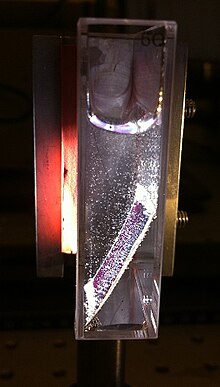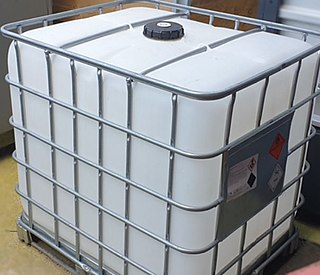Hydrogen production
Photoelectrochemical

In a solar photoelectrochemical process, hydrogen can be produced by electrolysis. To use sunlight in this process, a photoelectrochemical cell can be used, where one photosensitized electrode converts light into an electric current that is then used for water splitting. One such type of cell is the dye-sensitized solar cell. [10] This is an indirect process, since it produces electricity that then is used to form hydrogen. Another indirect process using sunlight is conversion of biomass to biofuel using photosynthetic organisms; however, most of the energy harvested by photosynthesis is used in life-sustaining processes and therefore lost for energy use. [7]
A semiconductor can also be used as the photosensitizer. When a semiconductor is hit by a photon with an energy higher than the bandgap, an electron is excited to the conduction band and a hole is created in the valence band. Due to band bending, the electrons and holes move to the surface, where these charges are used to split the water molecules. Many different materials have been tested, but none so far have shown the requirements for practical application. [11]
Photochemical
In a photochemical process, the sunlight is directly used to split water into hydrogen and oxygen. Because the absorption spectrum of water does not overlap with the emission spectrum of the sun, direct dissociation of water cannot take place; a photosensitizer needs to be used. Several such catalysts have been developed as proof of concept, but not yet scaled up for commercial use; nevertheless, their relative simplicity gives the advantage of potential lower cost and increased energy conversion efficiency. [7] [12] One such proof of concept is the "artificial leaf" developed by Nocera and coworkers: a combination of metal oxide-based catalysts and a semiconductor solar cell produces hydrogen upon illumination, with oxygen as the only byproduct. [13]
Photobiological
In a photobiological process, the hydrogen is produced using photosynthetic microorganisms (green microalgae and cyanobacteria) in photobioreactors. Some of these organisms produce hydrogen upon switching culture conditions; for example, Chlamydomonas reinhardtii produces hydrogen anaerobically under sulfur deprivation, that is, when cells are moved from one growth medium to another that does not contain sulfur, and are grown without access to atmospheric oxygen. [14] Another approach was to abolish activity of the hydrogen-oxidizing (uptake) hydrogenase enzyme in the diazotrophic cyanobacterium Nostoc punctiforme , so that it would not consume hydrogen that is naturally produced by the nitrogenase enzyme in nitrogen-fixing conditions. [15] This N. punctiforme mutant could then produce hydrogen when illuminated with visible light.
Another mutant Cyanobacteria, Synechocystis, is using genes of the bacteria Rubrivivax gelatinosus CBS to produce hydrogen. The CBS bacteria produce hydrogen through the oxidation of carbon monoxide. Researchers are working to implement these genes into the Synechocystis. If these genes can be applied, it will take some effort to overcome the problems of oxygen inhibition in the production of hydrogen, but it is estimated that this process can potentially yield as much as 10% solar energy capture. This makes photobiological research a very exciting and promising branch of the hydrogen production explorations. Still the problems of overcoming the short-term nature of algal hydrogen production are many and research is in the early stages. However, this research provides a viable way to industrialize these renewable and environmental friendly processes. [16]
Thermochemical
In the solar thermochemical [17] process, water is split into hydrogen and oxygen using direct solar heat, rather than electricity, inside a high temperature solar reactor [18] which receives highly concentrated solar flux from a solar field of heliostats that focus the highly concentrated sunlight into the reactor.
The two most promising routes are the two step cerium oxide cycle and the copper chlorine hybrid cycle. For the cerium oxide cycle the first step is to strip the CeO3 into Ce2O3 at more than 1400 °C. After the thermal reduction step to reduce the metal oxide, hydrogen is then produced through hydrolysis at around 800 °C. [19] [20] The copper chloride cycle requires a lower temperature (~500°C), which makes this process more efficient, but the cycle contains more steps and is also more complex than the cerium oxide cycle. [19]
Because hydrogen manufacture requires continuous performance, the solar thermochemical process includes thermal energy storage. [21] Another thermochemical method uses solar reforming of methane, a process that replicates traditional fossil fuel reforming process but substitutes solar heat. [22]
In a November 2021 publication in Nature, Aldo Steinfeld of Swiss technological university ETH Zurich reported an artificial photosynthesis where carbon dioxide and water vapour absorbed from the air are passed over a cerium oxide catalyst heated by concentrated solar power to produce hydrogen and carbon monoxide, transformed through the Fischer-Tropsch process into complex hydrocarbons forming methanol, a liquid fuel. Scaling could produce the 414 billion L (414 million m3) of aviation fuel used in 2019 with a surface of 45,000 km2 (17,000 sq mi): 0.5% of the Sahara Desert. [23] [24] [25] One author, Philipp Furler, leads specialist Synhelion, which in 2022 was building a solar fuel production facility at Jülich, west of Cologne, before another one in Spain. [26] Swiss airlines, part of the Lufthansa Group, should become its first customer in 2023. [26]








